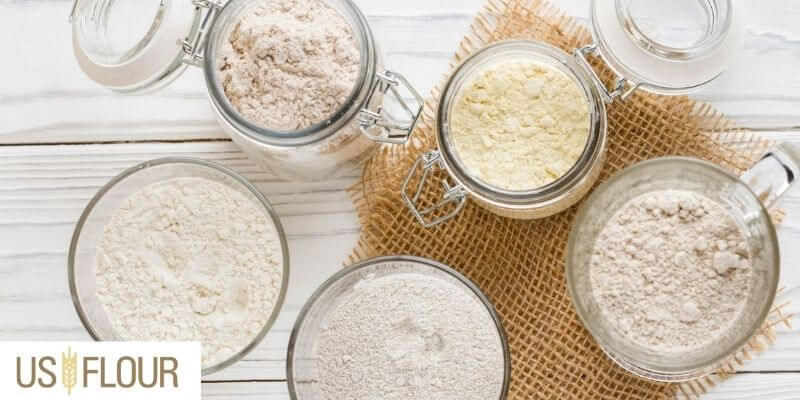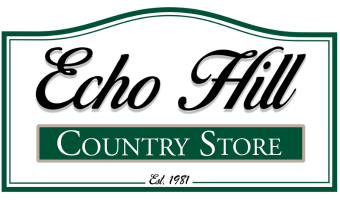Choosing Your Flour
With the many types of flours available, it can be a bit difficult to decide what kind of flour you need for your particular baking project.
In this pamphlet we try to clear up some of the confu- sion regarding how flours are categorized — and help you choose the right one for your next project.
How are flours usually categorized?
White flours are divided by protein content (also called gluten level).
The protein content in flour is measured as a percent- age. For example, 11.7% of each cup of King Arthur All- Purpose flour is protein, the remaining 88.3% is mostly starch. Protein level is possibly the most important thing to consider when choosing a flour. The more protein a flour has, the more liquid it absorbs. This means that if you are changing the type of flour used in a recipe, you may have to adjust the amount of flour and/or liquid to keep the dough from being too wet or too dry.
The more protein in the flour you use, the chewier the final product will be. This means that the opposite is also true: lower protein flours produce more tender baked goods. For this reason you may choose to use a very high protein flour for bagels (a traditionally chewy bread) and a low protein flour for pie crust (if you want a tender crust).
Generally speaking, these are the effects of protein
levels on specific baked goods:
- More protein in a flour will help breads and other yeasted products rise higher and be more “airy”.
- More protein in a flour will make cookies and biscuits spread less.
- More protein in a flour can help support heavy ingredients, like dried fruit and nuts, in breads and muffins.
All Purpose White Flour
The name explains it well. All purpose flour is designed to work great in a variety of uses. It usually contains some malted flour to enhance it’s performance for yeast baking. Quality all purpose flour, such as “King Arthur”, has not been subjected to a bleaching process. This flour is an excellent choice for a wide variety of baking pro- jects, from cookies to breads. Also it works well in bread machines.
- “Snavely’s Stone Ground Whole Wheat Bread Flour” A finely ground flour milled from hard red spring wheat. Suitable for a traditional whole wheat bread.
- “Prairie Gold Whole Wheat Flour” Certified Chemical Free. Milled from hard white spring wheat, this flour is excellent for bread, pancakes, pizza crusts, and more. Use when you want the benefits of whole wheat, but don’t want the strong taste of red wheat.
- “Bronze Chief Whole Wheat Flour” Certified Chemical Free. Milled from hard red spring wheat. Excellent for bread, pancakes, waffles, etc.
- “Organic Whole Wheat Pastry Flour” Milled from soft white winter wheat. Provides a “whiter” pastry, with the advantages of whole wheat.
- “Snavely’s Whole Wheat Pastry Flour” Milled from soft red winter wheat.
White Bread Flour
What really is the difference between all purpose flour and bread flour? The main difference is the protein content. Bread flour has about 12.7% protein, and all purpose would be about 11.7% As noted before, this produces a chewier product, and helps the dough support the nuts, dried fruit, and other grain flours commonly used in bread baking.
Pastry flour.
Flour that’s labeled as “pastry flour” normally has a lower protein content than all purpose flours. It can be used for pastries and cakes, but because it is normally unbleached, cakes made from this flour won’t rise quite as high and the texture will not be as light. For those interested in customizing your baking, this flour can be used in conjunction with all purpose flour in various proportions, thereby achieving the kind of texture you want in whatever your are baking.
Bleached White Flour
(aka Cake Flour)
Cake Flour, such as “Pure-as-Snow”, also has a low pro- tein content. However, this flour is subjected to a bleaching process, which changes the nature of the wheat starch, allowing it to absorb more liquid. This means that bleached cake flour will be able to support the large amounts of fat and sugar often used in cakes. Bleaching flour also makes it more acidic. The higher acidity helps the starch “set” in the oven more quickly. These things combined produce the lighter texture sought in cakes. Using unbleached flour for cakes will result in more body, which some people prefer.
High quality pastry flour is never bleached, as untreated gluten, handled gently, will produce a more tender and flakey result. Good bread flour also should not be bleached since this interferes with the development of gluten in the dough. Cake flour is treated with bleach to give it the characteristics that many bakers desire.
Self-Rising Flour
Flours can also be categorized by the special ingredients they contain, like the baking powder in “Self Rising” flour. Here is a simple recipe to make it yourself:
1cup pastry flour, or all purpose flour 1½ tsp. baking powder
1/8 tsp. salt
Here is a sample list of the white wheat flours we offer at Echo Hill:
- “King Arthur” Hi-Gluten Flour. Used to make chewy bagels, lighten rye or multigrain breads, and for some pizza dough. It has a protein con- tent of about 14.2%. Can be used in bread ma- chines.
- “King Arthur” Special Bread Flour Milled from hard red spring wheat and has a higher protein content than all purpose flour, about 12.7%. Best used for yeasted items, like breads and pizza crust. This is a great flour to use in bread machines.
- “King Arthur” All Purpose Flour Milled from hard red wheat with a protein level of about 11.7 percent. Truly “all purpose”, this flour can be used successfully for everything from breads to cookies. Also excellent for bread machines.
- “King Arthur” Organic All Purpose Flour an organic flour with the same properties as the regular all purpose flour.
Cake and Pastry Flours (White)
- “White Rose Unbleached Pastry Flour” Milled from local soft red winter wheat.
- “Pure-as-Snow Cake Four” A bleached white flour suitable for cakes.
Whole Wheat Flours
Whole wheat flour is just that – flour made from the whole wheat kernel. Baked goods made from whole wheat flours will be slightly heavier in texture, and stronger in taste. Comparatively new on the mar- ket is “white wheat”, a variety of wheat that has a lighter bran, and produces results more like white flour, yet has the benefits of being whole wheat.
- “King Arthur Organic Whole Wheat Flour” A classic organic whole wheat flour, usable in any recipe that calls for whole wheat, especially when you want the flavor of the grain to shine through.
What if I don’t have the right flour?
What can I substitute?
The flour you want to use has more protein than the flour the recipe calls for, for example you have bread flour but the recipe calls for all-purpose flour:
You can lower the protein content of a flour a few notch- es by adding some cornstarch. So for example, you can make a substitute for all-purpose flour (protein level 11 .7%) out of bread flour (protein level 12.7%) by putting a tablespoon of cornstarch into the bottom of a 1 cup measuring cup — then measuring the bread flour into that cup. Repeat this process for every cup of flour needed in the recipe. If the dough or batter seems too dry after mixing, add a little water a tablespoon at a time until it feels right. The final baked good may not be as tender as it would have been if you had used the correct flour.
There is no good substitute for cake flour, and the above trick may not work if your recipe specifically asks for cake flour.
If the flour you want to use has less protein than the flour the recipe calls for, for example you have pastry flour but the recipe calls for all-purpose flour:
This is a little harder. You could try adding a tablespoon of vital wheat gluten (if you have some) to the dough or bat- ter. You could also just go ahead and use the lower protein flour with no other changes — and just keep in mind that the results may be more tender and crumblier than usual. Some items may not hold together as well as they would have with the correct flour. If the dough or batter seems too wet after mixing, add a little more flour a tablespoon at a time.
Vital Wheat Gluten:
Vital Wheat Gluten (or gluten flour) is flour that has been wet to activate the gluten-producing proteins, washed to remove the starchy part of the flour, then dried and milled back to a flour-like consistency. Do not confuse this with high-gluten flour. This product is pure wheat gluten, not flour. It can be added, about a tablespoon per loaf to bread dough that contains low protein flours or meals (ryes, oats, corn, etc.) or a lot of extras (such as dried fruits, nuts, cheese, or onions) to produce lighter loafs.

